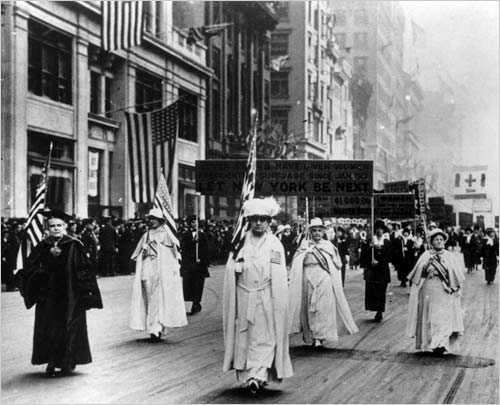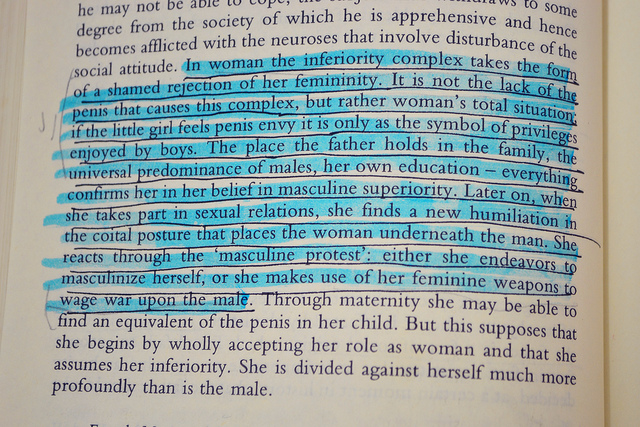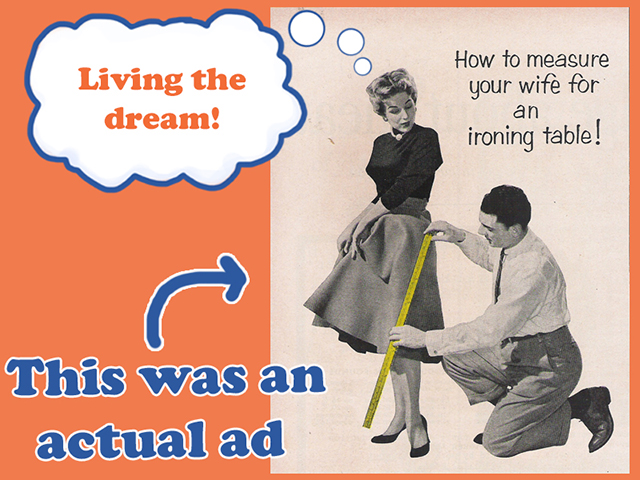There are these two words that come up in women’s studies all the time: reading and writing. They’re kind of the core values of an interdisciplinary major based in theory and personal essays — you need to be able to read someone else’s and write your own. Women’s Studies is an academic field, which has run into a fair share of criticism for that very fact over time. Yes, we’re all words. Yes, sometimes we’re all words and no action. But we study the damaging effects of gender, dude. And that matters.
There are some key writings in the field that are often cited but rarely make it out of the realm of academics — and I think it’s time to change that. In line with the values of this column, I’d like to share some of the formative pieces of this beast we call “women’s studies” with you, which coincidentally is also a great way to observe the changes in language and theory that have impacted its course – and our lives.
Because this is a historically grounded look at feminist writing, I’ve compiled this list with an intense focus on the context and immediate impact of the works. For that reason, there may be works here or in future posts that were influenced or written by flawed individuals with problematic ideas in areas we don’t fully explore here, as well as pieces that espouse outdated theories about women’s lives and the feminist movement. For instance, many feminist movements have explicitly or implicitly excluded women of color; second-wave feminists were often homophobic and lesbophobic; many feminists throughout the years have rejected trans women or endorsed transmisogynistic concepts of gender. This is in no way an endorsement of the shitty things these people, groups, or theories have done or influenced — it’s just me presenting you with something that was really important at the time that they wrote, performed, or constructed it. Women’s Studies is about the evolutions of feminist theory, and we can’t fully understand that without acknowledging its former and current faults.
AUTHOR’S NOTE: Y’all were quick to spotlight that I left out the Combahee River Collective statement in the comments when I originally posted this, and I’ve since fixed this egregious error. Thank you for pointing it out!
A Vindication of the Rights of Woman: with Strictures on Political and Moral Subjects (1792)
Mary Wollstonecraft unfortunately made history when she demanded — and made a damn good case for — women’s ability to pursue higher education (and really, education at all) in 1792 with her Vindication. The writing, which now stands as a historical document in the women’s movement, declares women as “partners” rather than wives and makes a solid case for the need to keep women in the sphere of intellectuals: the future of the human race.
There are many follies, in some degree, peculiar to women: sins against reason of commission as well as of omission; but all flowing from ignorance or prejudice, I shall only point out such as appear to be particularly injurious to their moral character. And in animadverting on them, I wish especially to prove, that the weakness of mind and body, which men have endeavoured, impelled by various motives, to perpetuate, prevents their discharging the peculiar duty of their sex: for when weakness of body will not permit them to suckle their children, and weakness of mind makes them spoil their tempers — is woman in a natural state?
Ain’t I A Woman? (1827)
Sojourner Truth’s historical critique of what is now called “white feminism” will never die. And it will always resonate. We live in a fucked up world — and this is the challenge it needs every day.
And ain’t I a woman? Look at me! Look at my arm! I have ploughed and planted, and gathered into barns, and no man could head me! And ain’t I a woman? I could work as much and eat as much as a man – when I could get it – and bear the lash as well! And ain’t I a woman? I have borne thirteen children, and seen most all sold off to slavery, and when I cried out with my mother’s grief, none but Jesus heard me! And ain’t I a woman?
Then they talk about this thing in the head; what’s this they call it? [member of audience whispers, “intellect”] That’s it, honey. What’s that got to do with women’s rights or negroes’ rights? If my cup won’t hold but a pint, and yours holds a quart, wouldn’t you be mean not to let me have my little half measure full?
The Declaration of Sentiments (1848)
You could possibly call this “the catalyst document.” As confident as I am that, at some point, American women in every generation would have recognized their own subservience, this document did a good job of doing it for us. The questionably first-ever official “feminist publication” written at what you could call the first-ever “feminist conference,” it’s the ultimate guide to the early feminist movement.
The Declaration of Sentiments was written at the Seneca Falls Convention, which made history just by happening and convened women from across America in efforts to construct a set of demands for their country. Mirrored after the Declaration of Independence, it both announced an organized effort for women’s rights in centuries to come and exposed the inherent and gendered imbalance of power ruling this country way back when (and, let’s be real, today).

We hold these truths to be self-evident: that all men and women are created equal; that they are endowed by their Creator with certain inalienable rights; that among these are life, liberty, and the pursuit of happiness; that to secure these rights governments are instituted, deriving their just powers from the consent of the governed. Whenever any form of government becomes destructive of these ends, it is the right of those who suffer from it to refuse allegiance to it, and to insist upon the institution of a new government, laying its foundation on such principles, and organizing its powers in such form, as to them shall seem most likely to effect their safety and happiness. Prudence, indeed, will dictate that governments long established should not be changed for light and transient causes; and accordingly all experience hath shown that mankind are more disposed to suffer. while evils are sufferable, than to right themselves by abolishing the forms to which they are accustomed. But when a long train of abuses and usurpations, pursuing invariably the same object, evinces a design to reduce them under absolute despotism, it is their duty to throw off such government, and to provide new guards for their future security. Such has been the patient sufferance of the women under this government, and such is now the necessity which constrains them to demand the equal station to which they are entitled. The history of mankind is a history of repeated injuries and usurpations on the part of man toward woman, having in direct object the establishment of an absolute tyranny over her. To prove this, let facts be submitted to a candid world.
The Second Sex (1949)

Simone de Beauvoir’s The Second Sex is so accurate when it comes to sexism that it’s banned by the Vatican. That is all.
The Feminine Mystique (1963)

In Betty Friedan’s landmark survey of unsurprisingly uninspired housewives, she found a common problem — one with no name — among them, and it would become the basis for the modern feminist movement as we know it. Friedan would go on to do both good and bad in the world as founder of the National Organization for Women and creator of the “lavender menace” trope that kept lesbians out of it until 1971. Her work also served to alienate and render invisible working-class women, who didn’t have the privilege of being a full-time homemaker. Nonetheless, her book illuminated the tiresome realm of domesticity and challenged the idea that being restricted to childbearing and homekeeping satisfied women at the core; in doing so, she became a touchstone of the modern-day feminist movement.
SCUM Manifesto (1967)
Valeria Solanas is famous for many things — most notably, for shooting Andy Warhol and for her public diagnosis of paranoid schizophrenia. But before she did that, she wrote this thing called the Society for Cutting Up Men Manifesto, and it shook everyone’s fucking world. Once you get past the homicidal man-hating vibes (unless you’re into that, no judgment, I love you just the way you are), the document proves to be a thorough analysis of the plethora of institutions and traditions that are inherently damaging to our lives — including sexism, capitalism, and all the shit in between — and what women can do to save themselves and everyone else from its structures.
SCUM will become members of the unwork force, the fuck-up force; they will get jobs of various kinds an unwork. For example, SCUM salesgirls will not charge for merchandise; SCUM telephone operators will not charge for calls; SCUM office and factory workers, in addition to fucking up their work, will secretly destroy equipment. SCUM will unwork at a job until fired, then get a new job to unwork at.
SCUM will forcibly relieve bus drivers, cab drivers and subway token sellers of their jobs and run buses and cabs and dispense free tokens to the public.
SCUM will destroy all useless and harmful objects — cars, store windows, ‘Great Art’, etc.
Eventually SCUM will take over the airwaves — radio and TV networks — by forcibly relieving of their jobs all radio and TV employees who would impede SCUM’s entry into the broadcasting studios.
SCUM will couple-bust — barge into mixed (male-female) couples, wherever they are, and bust them up.
The Woman-Identified-Woman (1970)
There came a time in every radical feminist lesbian’s life in the midst of the second wave where she stuck her head out the window and screamed “I’m mad as hell and I’m not gonna take it anymore!” The Radicalesbians, however, put a spin on the whole tradition as the “lavender menace” ruled over the women’s movement and presented a 10-paragraph manifesto of their frustrations in the nation’s capitol. Or, more accurately, they totally cut power to Congress and overtook a session to read their manifesto aloud, challenging feminists and legislators to take up the mantle of empowering queer women alongside straight women and demanding of our institutions that they reflect their experiences and needs. It was exactly the ass-kicking everyone needed.
“The Woman-Identified Woman” stands strong in my heart as the primary source that brought me to women’s studies and kept me there for life. It is a cold but necessary departure from the “no, but seriously, I’m totally into dudes and ponies” bullshit that mainstream feminism has propagated for, well, ever, and in that way it set the tone for the future of the queer women’s movement. The Radicalesbians didn’t care about how bad for the cause it might be for them to disavow men, stand strong with one another, and declare themselves to be who they really were – and their bravery shines in every word.
It’s worth noting that the radical feminist movement later devolved into rampant transphobia and transmisogyny, and has since wrought havoc on the real movement for full women’s equality. But back then, this piece was the most powerful example to date of lesbian feminists taking a space that was rightfully theirs and unabashedly making themselves at home there. Each paragraph is a serious lesson in the patriarchal socialization that creates women’s experiences, and looking back now it’s honestly just absurd to imagine that it took ’til 1970 for someone to say it out loud.
What is a lesbian? A lesbian is the rage of all women condensed to the point of explosion. She is the woman who, often beginning at an extremely early age, acts in accordance with her inner compulsion to be a more complete and freer human being than her society – perhaps then, but certainly later — cares to allow her. These needs and actions, over a period of years, bring her into painful conflict with people, situations, the accepted ways of thinking, feeling and behaving, until she is in a state of continual war with everything around her, and usually with her self.
The Combahee River Collective Statement (1977)
The groundbreaking manifesta of the Combahee River Collective — a group formed within the National Black Feminist Organization in the early ’70s — was the first-ever social justice document that spotlighted the concept of “interlocking oppressions,” which later evolved into the popularized philosophy of “intersectionality.” The document also coined the term “identity politics,” which, prior to being co-opted by the right wing to diss us all, stood for a philosophy which saw justice and oppression as inextricably linked to who we were and achieving solutions as equally important to center around those identities.
Unfortunately, the Combahee River Collective — which was comprised exclusively of women of color and established Black feminism by centering those experiences in their feminist work — rarely receives credit for completely revolutionizing how we think about social justice, gender, race, and everything else.
Above all else, Our politics initially sprang from the shared belief that Black women are inherently valuable, that our liberation is a necessity not as an adjunct to somebody else’s may because of our need as human persons for autonomy. This may seem so obvious as to sound simplistic, but it is apparent that no other ostensibly progressive movement has ever consIdered our specific oppression as a priority or worked seriously for the ending of that oppression. Merely naming the pejorative stereotypes attributed to Black women (e.g. mammy, matriarch, Sapphire, whore, bulldagger), let alone cataloguing the cruel, often murderous, treatment we receive, Indicates how little value has been placed upon our lives during four centuries of bondage in the Western hemisphere. We realize that the only people who care enough about us to work consistently for our liberation are us. Our politics evolve from a healthy love for ourselves, our sisters and our community which allows us to continue our struggle and work.
This focusing upon our own oppression is embodied in the concept of identity politics. We believe that the most profound and potentially most radical politics come directly out of our own identity, as opposed to working to end somebody else’s oppression. In the case of Black women this is a particularly repugnant, dangerous, threatening, and therefore revolutionary concept because it is obvious from looking at all the political movements that have preceded us that anyone is more worthy of liberation than ourselves. We reject pedestals, queenhood, and walking ten paces behind. To be recognized as human, levelly human, is enough.
This Bridge Called My Back: Writings by Radical Women of Color (1981)
This Bridge Called My Back was the pre-Internet version of #SolidarityIsForWhiteWomen, only more academic and everlasting. And that’s what makes it beautiful. Women of color came together to write about exclusion and inclusion in the feminist movement for this groundbreaking anthology, blasting white women for exploiting and overlooking them time and again in the name of women’s equality.
Women, Race, and Class (1983)
I can’t publish a list of important feminist books without publishing Angela Davis’ name. In Women, Race, and Class, the one and only badass theorist schools us all in intersectionality and explores how bias has always inclined the desires of what should be a shared movement for women’s rights toward those who already experience the greatest privilege. If you thought feminism was flawless by now, you’re just not doing the work. But if you thought it was unfixable, you just haven’t spent enough time trying to be Angela Davis. From abolition to right now, this book chronicles missed chances for real change and inclusion, and makes you more determined than ever to never miss them again.
A Vindication of the Rights of Whores (1989)

The 1989 COYOTE Vindication of the Rights of Whores is an anthology preaching the immense importance of the recognition of and respect for sex workers by the feminist movement and the world at large. Edited by Margo St. James herself, it is an early example of sex workers demanding their fair share of the feminist movement and their own humanities. The piece is now a commonplace reference for those interested in the rights of sex workers and the advancement of their status; at the time of its publication, it made history by laying out the first-ever World Charter for Prostitutes’ Rights and publishing the writing of actual sex workers.
Gender Trouble: Feminism and the Subversion of Identity (1990)
I know. I know. Judith Butler is totally maybe overrated and completely inaccessible and one hundred percent an academic — but she still authored an amazing, albeit dense, account of our own inner struggles to articulate and perform our genders, and broke boundaries doing it, too. For that, she can have all of my tuition money, including interest, and maybe even deserves a gourmet cupcake of her choosing on top (because we’re into that here in DC). Reading Judith Butler always makes me take a deep look at myself in which I think: it took a degree to read this shit, but it’s motherfucking worth it.
Cyborg Manifesto (1991)

Have you ever considered that you’re not really a woman at all? Or that you’re actually a fucking ROBOT? We have an essay for that, and it gives all of us WGST majors deep joy to reflect upon.
“The Cyborg Manifesto” challenges us all to realize how sexism has stripped us of our humanity — and what it means for our culture and lived experiences. If you never before challenged yourself to imagine how rigidly constructed your world was in comparison to, say, that of a universe which enjoys none of your so-called “human” experiences at all, this text will drive it home.
Everything is man-made, even sexism. Everything is constructed, even gender. And everything is fucked — even what used to be our shared fantasy.
A cyborg is a cybernetic organism, a hybrid of machine and organism, a creature of social reality as well as a creature of fiction. Social reality is lived social relations, our most important political construction, a world-changing fiction. The international women’s movements have constructed ‘women’s experience’, as well as uncovered or discovered this crucial collective object. This experience is a fiction and fact of the most crucial, political kind. Liberation rests on the construction of the consciousness, the imaginative apprehension, of oppression, and so of possibility. The cyborg is a matter of fiction and lived experience that changes what counts as women’s experience in the late twentieth century. This is a struggle over life and death, but the boundary between science fiction and social reality is an optical illusion.
The Transfeminist Manifesto (1993)
As the queer movement and the women’s movement began to more regularly intersect, the politics of trans inclusion became a key source of tension and frustration. “The Transfeminist Manifesto,” by Emi Koyama, demands an end to it all with a common-sense argument: that trans women should be fully respected and celebrated in feminist spaces and the feminist movement. Anyone who disagrees can get the fuck out.
Every time a group of women previously silenced begins to speak out, other feminists are challenged to rethink their idea of whom they represent and what they stand for. While this process sometimes leads to a painful realization of our own biases and internalized oppression as feminists, it eventually benefits the movement by widening our perspectives and constituency. It is under this understanding that we declare that the time has come for trans women to openly taker part in the feminist revolution, further expanding the scope of the feminist movement.
The Empire Strikes Back: A Post-Transsexual Manifesto (1993)
Influenced by early drafts of “The Cyborg Manifesto” (because academics ride together, die together, etc.), “The Empire Strikes Back” is a groundbreaking and historic text which explored the silencing and shaming of trans folks by gay, lesbian, and bisexual activists and urged them to do as their LGB counterparts had done and come out already. Author Sandy Stone makes a solid case for the importance of trans solidarity and visibility, and thus reclaims the language of the gay rights movement for all the queers living under the trans umbrella.
By encouraging trans folks to live out and proud, the text demands more than their full inclusion: it demands their full self-actualization.
Powers beyond my control had brought me to Room 5 at the clinic in Casablanca, and I could not have run away then even if I had wanted to. I went to say good-bye to myself in the mirror. We would never meet again, and so I wanted to give that other self a long last look in the eye, and a wink for luck.
Feminism Is for Everybody: Passionate Politics (2000)
bell hooks redefined feminism, especially when she purposefully and proudly made room for women of color within the movement. Feminism Is For Everybody broke down the barriers to feminism faced by pretty much everyone except white, middle-class cis women and made it clear that the now-familiar challenge to a movement for broad women’s equality was, indeed, still working toward creating a movement for, well, broad women’s equality.
bell hooks has consistently challenged us to look deeper within feminism for barriers put in place by race, class, and other factors to our own empowerment alongside our sisters — and this book sets a good standard for that examination.
Have your own suggestions? That’s okay, because I teach in the abstract method of “comment to be recognized as assistant professor.” Think I’m missing something? Just leave it in the comments. Trust me, I appreciate it.







